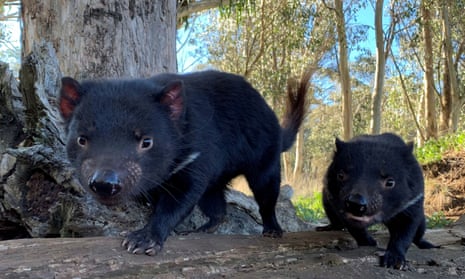The spread of a facial cancer that ravaged the Tasmanian devil population has slowed due to the animal’s “amazing evolutionary response”, increasing its chance of survival, new research suggests.
An international team of scientists used a genomic tool typically used to track viruses such as Covid-19 to monitor the spread of the transmissable cancer that has led to devil numbers crashing by more than 80% over the past two decades.
Called devil facial tumour disease, or DFTD, the unusual illness is passed between animals by biting. There was concern a decade ago that it could lead to the marsupial’s extinction as it moved into populations across most of the island state.
But a new paper in the journal Science says the spread of the cancer has slowed – the curve has flattened – and it is now thought unlikely to wipe out the endangered species.
Prof Andrew Storfer, a biologist from Washington State University in the US who led the research, said the results were “cautiously optimistic good news”.
“I think we’re going to see continued survival of devils – initially at lower numbers and densities than original population sizes, but extinction seems really unlikely even though it was predicted a decade ago,” he said in a statement.
The study expands on earlier work led by Dr Rodrigo Hamede, a disease ecologist at the University of Tasmania, which suggested a handful of devils had developed a natural immune response to the disease.
The new paper found that while DFTD was still usually fatal, the reproduction number of cases from each primary case had fallen from a high of about 3.5 to less than one.
The authors concluded devils were likely to have rapidly evolved to tolerate and possibly resist the cancer, and could now exist in a “steady state” with it.
They screened more than 11,000 genes from tumour samples collected over nearly 20 years using a genomic approach known as phylodynamics, which allowed analysis of changes in DNA to track the evolution of the disease through the population.
The researchers said there was increasing evidence some devils could recover from DFTD, which was not the case in its early incarnation. There are believed to be about 10,000 left in the wild.
Hamede, a co-author on the latest study, said he was amazed at the pace at which devils had evolved in response to DFTD.
“These things just don’t happen in four or five generations, they take a lot longer than that,” he said.
“This new research shows evidence that the epidemic reached its peak a while ago. We expect in the future devils are going to be making a comeback.”
The researchers said the results raised doubts about the future of programs that exist to release captive-bred devils into the wild, given breeding between animals exposed to the disease and those raised in captivity could slow or reverse the tumour-resistant evolution of the wild population.
Hamede said these sort of programs should only be undertaken only if it was clear the benefits were greater than allowing populations to recover through natural selection.
Storfer said: “Active management may not be necessary and could actually be harmful.”
